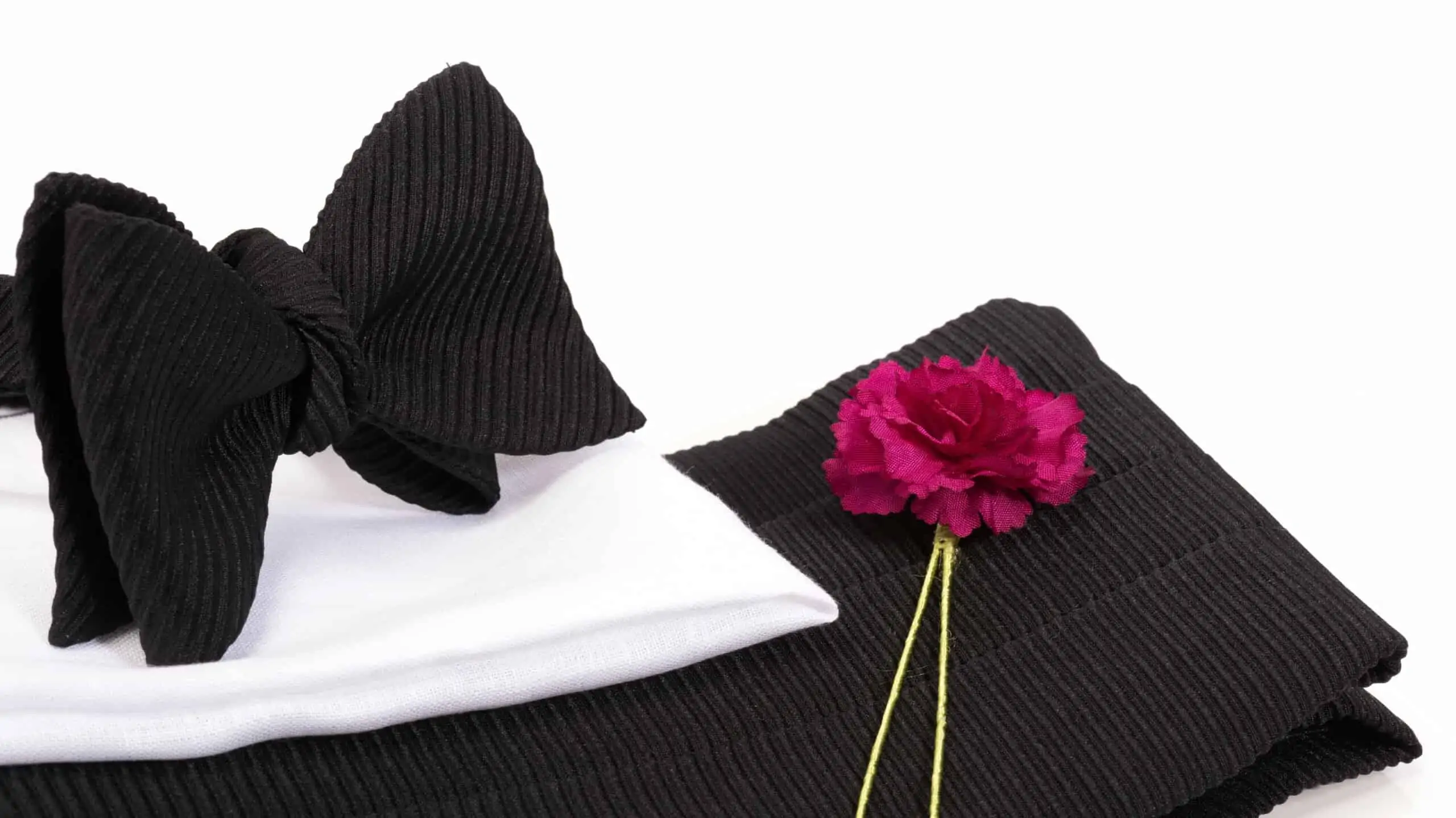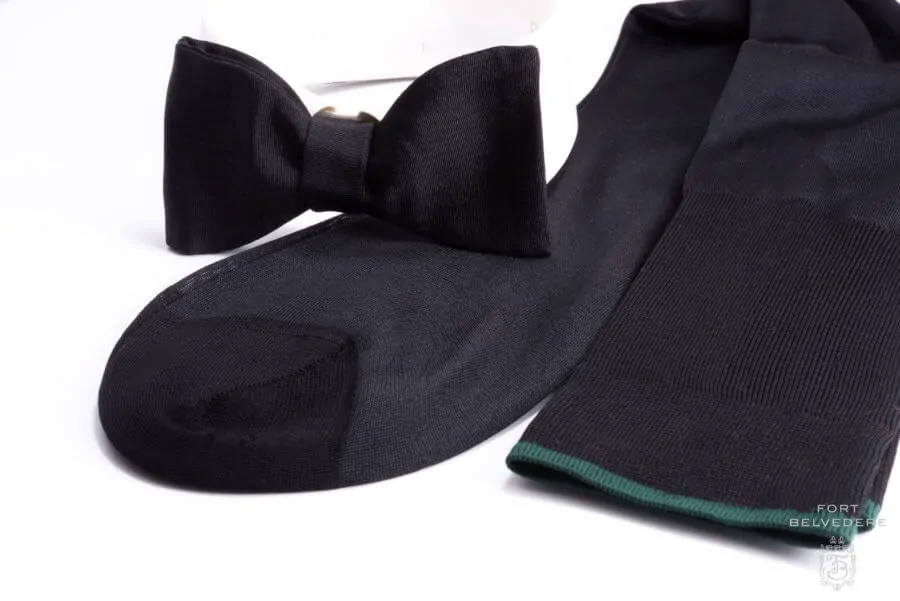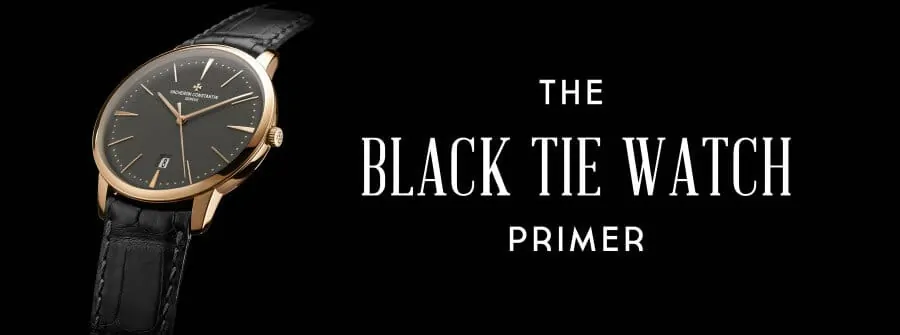Classic accessories add the finishing touches to a man’s black-tie kit and allow him to inject a dash of swank without degrading its inherent formality. Savvy dressers can use the following traditional variations to add a new twist to their tuxedo each time they wear it.
- Cufflinks and Studs: Essential Evening Accessories
- Waistcoat Buttons: Antique Accessories
- Evening Dress Socks For Black Tie
- Sock Garters / Suspenders: Thankfully Obsolete
- Evening Suspenders / Braces – Never A Belt
- Black Tie Watch: Optional Elegance
- White Linen Pocket Square
- Buttonhole Boutonniere: Optional Botanical Brilliance
- Evening Scarf: Optional Outerwear
- Evening Dress Gloves: Handy Option
- Jewelry: Rings
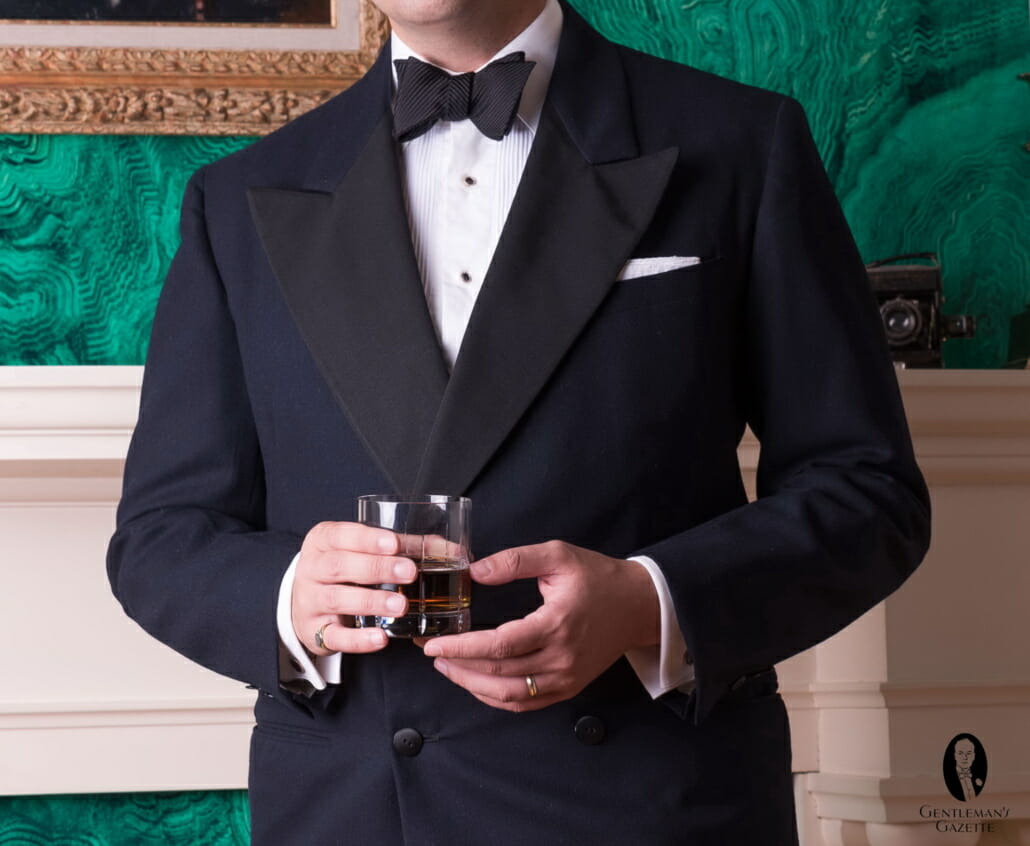
Cufflinks and Studs: Essential Evening Accessories
Classic black-tie shirt studs, cufflinks and waistcoat studs (if applicable) are typically yellow gold, rose gold, white gold, or platinum. Sometimes they have diamonds or other precious stones such as emeralds, rubies or sapphires. Since those are too expensive for most, semi-precious stones such as onyx, hematite, abalone of dark mother of pearl are often used instead. Of course, there are also many other options, including crystal and white mother of pearl, although those are also often seen on white tie ensembles.
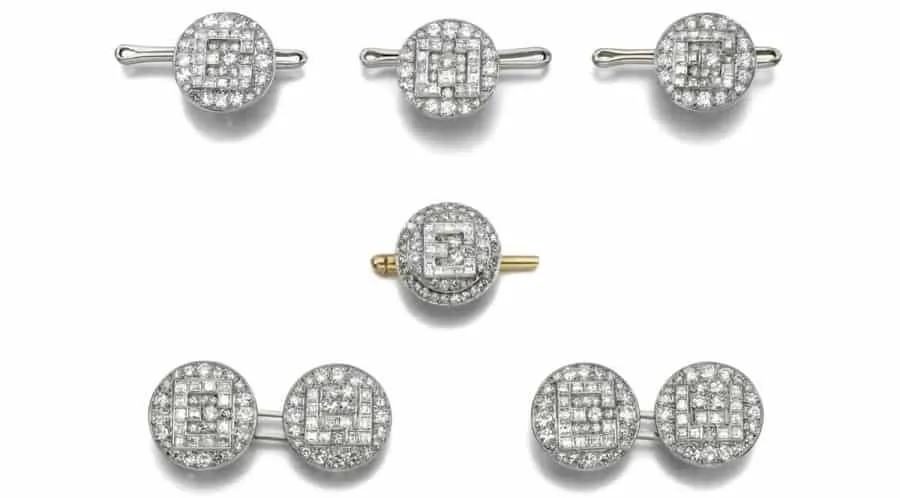
Ideally, shirt studs and cufflinks should be a set however if you can manage to get a close resemblance you are fine.
Try to avoid cheap t-bar cufflinks and go with double-sided cufflinks instead as that looks a lot more polished. While vintage shirt studs often look great, they are always too small for modern day evening shirt buttonholes. Because of that your shirt will pop open during a regular evening’s activities and expose your chest.
Modern day studs like these in platinum or yellow gold will stay fastened all evening, and you can get the matching cufflinks.
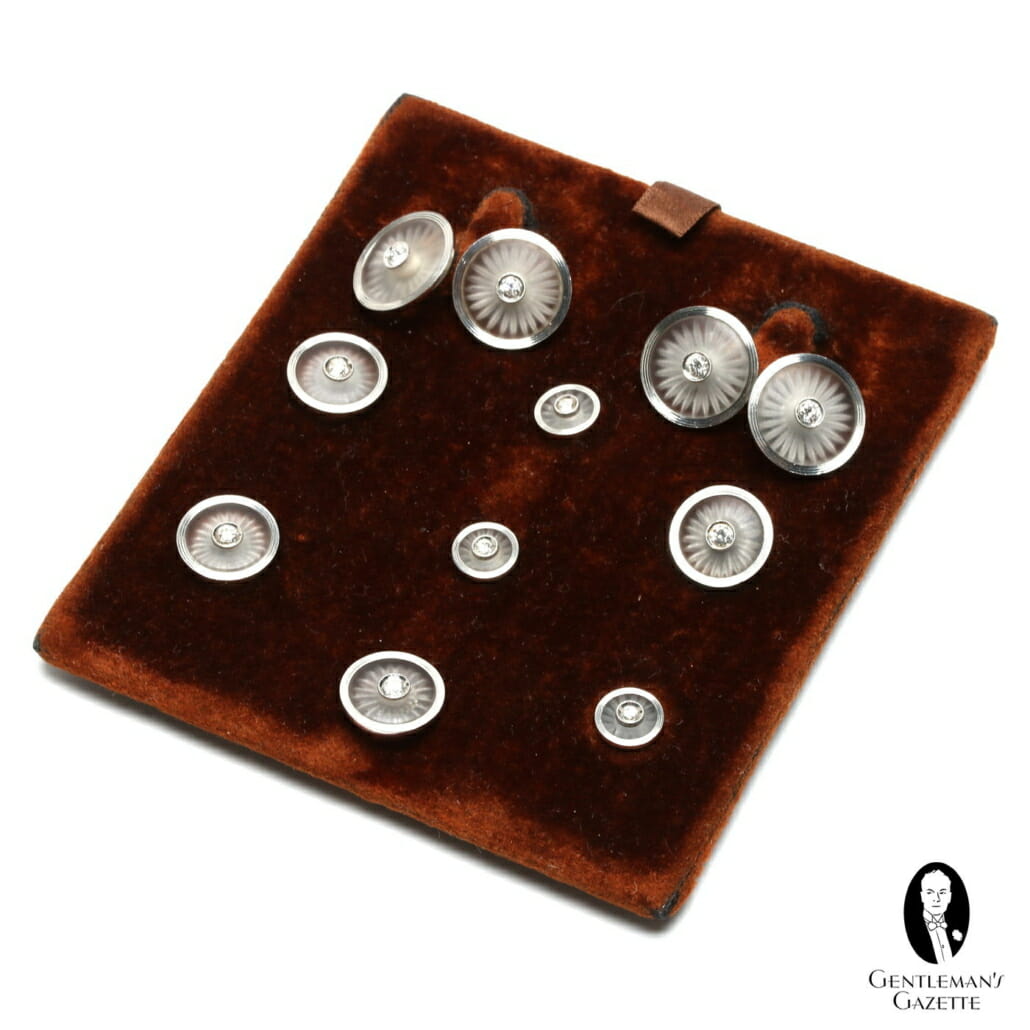
Waistcoat Buttons: Antique Accessories
Back in the day, you could also find removable waistcoat button pockets on black tie vests. Even though more typically found in a white tie setting, these full dress sets with 2 cufflinks, 3 shirt studs and 4 waistcoat buttons are large dress sets that are not easy to always easy to find but once you have them they will upgrade your black tie outfit indefinitely.
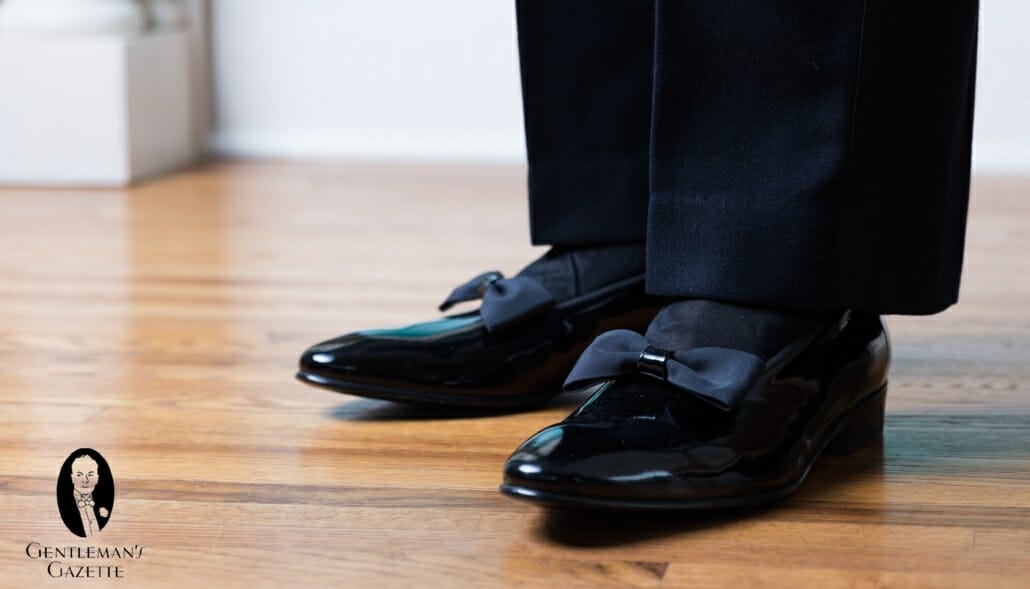
Evening Dress Socks For Black Tie
The most classic choice is a pair of black silk socks in over-the-calf length that are sized to your feet. The thin delicate silk has a smooth sheen which is the appropriate material for the black tie. The key is that they stay up.
The problem with most black silk socks on the market is, that they are too short and hence will slide down. This effect is compounded by the fact that silk socks generally slide down more easily than cotton or wool socks do. Drooping socks are not only unsightly but can also result in exposed shins when a man sits or crosses his legs.
Therefore Sven Raphael Schneider, founder for the Gentleman’s Gazette and Fort Belvedere designed a pair of socks with superior elastics so they stay up all evening. You can get those perfect black tie socks in 4 different sizes here.
Sock Garters / Suspenders: Thankfully Obsolete
In the 1930s, Socks were usually held in place by sock garters (sock suspender in the UK) to ensure that they did not sag or bunch, which used to be an unfortunate trait of silk hose. The problem with sock garters is that they are uncomfortable and because you can now cummerbund , there is no need to torture yourself with sock garters. Because of that sock garters are now obsolete.
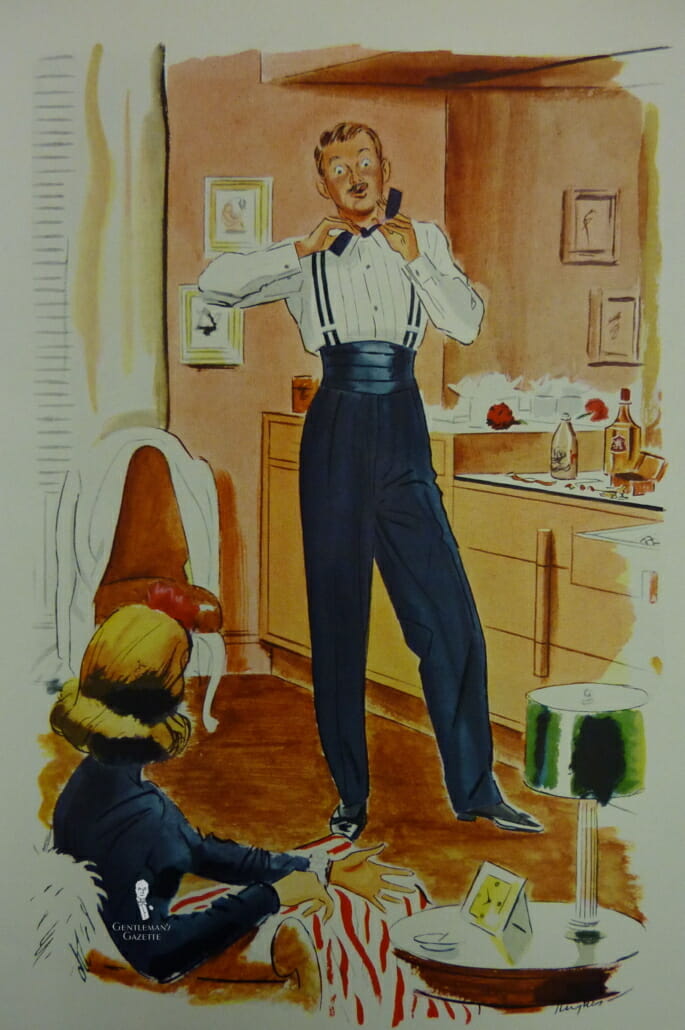
Evening Suspenders / Braces – Never A Belt
Unless trousers are custom tailored to stay securely in placewith side adjusters, suspenders (braces in the UK) are always worn with a tuxedo.
Belts are not an option because they would cause the cummerbund or waistcoat to bunch up. This is not just a matter of tradition but also of style because they ensure that the trouser waistband does not slip below the bottom of the waistcoat, they align the trousers’ pleats with the waistcoat’s points and they avoid the extra waistline bulk that would result from wearing a belt.
Formal suspenders are always the button-on variety – never clip-on – and they customarily feature soft, knitted ends instead of the stiffer and bulkier leather tabs found on ordinary suspenders.
They can be black or white silk or a combination of both. Traditionally, they are tubular braces lined in silk, and not just woven band suspenders. Typically, silk satin is very delicate which is why grosgrain or even better moiré silk suspenders are very classy. Some also wore striped suspenders like the gentleman above from the 1940s.
Ultimately, the preferred color is irrelevant because suspenders are underwear and as such are never meant to see the light of day. (This is one of the primary reasons that a gentleman never removes his jacket at a formal function.)
Black Tie Watch: Optional Elegance
Some consider it gauche to wear a timepiece to a formal occasion arguing that clock watching is contradictory to the celebratory nature of such events and insulting to the hostess. Those men who can’t conceive of being without a wristwatch for an entire evening should at least heed the advice of Glenn O’Brien, GQ’s Style Guy. “Just because it’s gold, is diamond festooned, and costs more than the average car doesn’t mean it’s a dressy watch,” he says. “Instead, opt for a slim, unadorned timepiece with a black leather band. A formal watch should keep time, not flash it.” A watch face with markings and a seconds hand that are minimal or non-existent is particularly well-suited to black tie’s refined minimalism. The metal trim should match the metal of the cufflinks.
Alternately, a formal affair is a wonderful excuse to carry a classic pocket watch and at least pretend to be unfettered by temporal constraints.
For a dedicated section on Tuxedo Watches, please head over here.
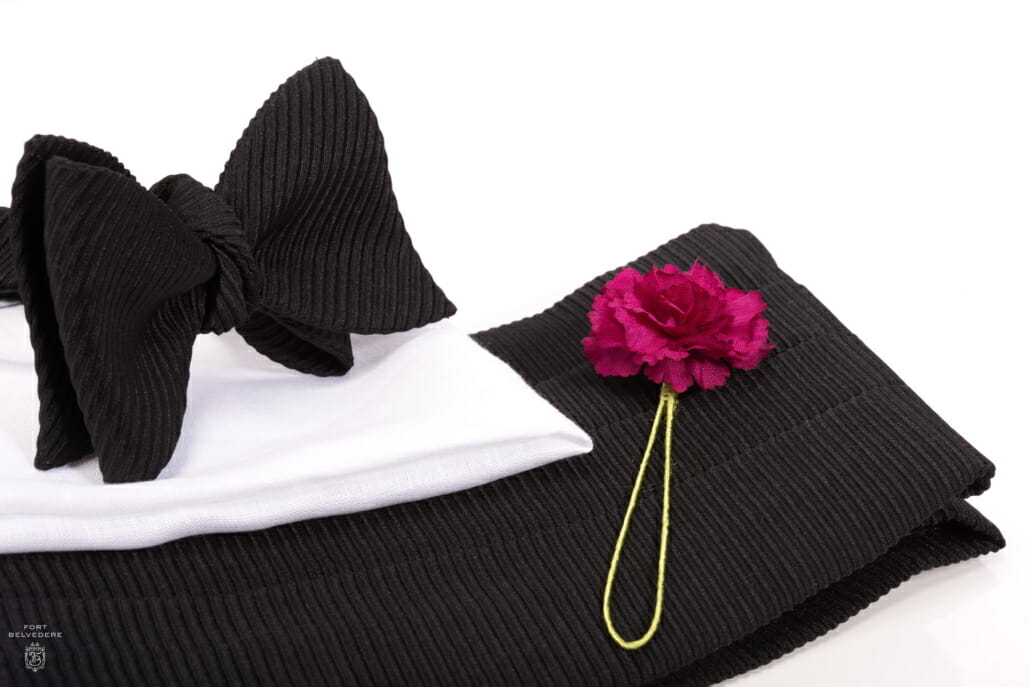
White Linen Pocket Square
The classic pocket square is a white, handrolled handkerchief of fine white linen, machine hemmed ones are cotton . Some style authorities suggest that the handkerchief be casually stuffed into the pocket in an irregular shape so as to add a human touch to an otherwise highly disciplined appearance. Other experts prefer the formal simplicity of the square-folded handkerchief. As for the precision-folded silk handkerchiefs seen on formalwear displays, they are best left to the mannequins.
Silk pocket squares are a modern variation and are discussed under contemporary accessories.
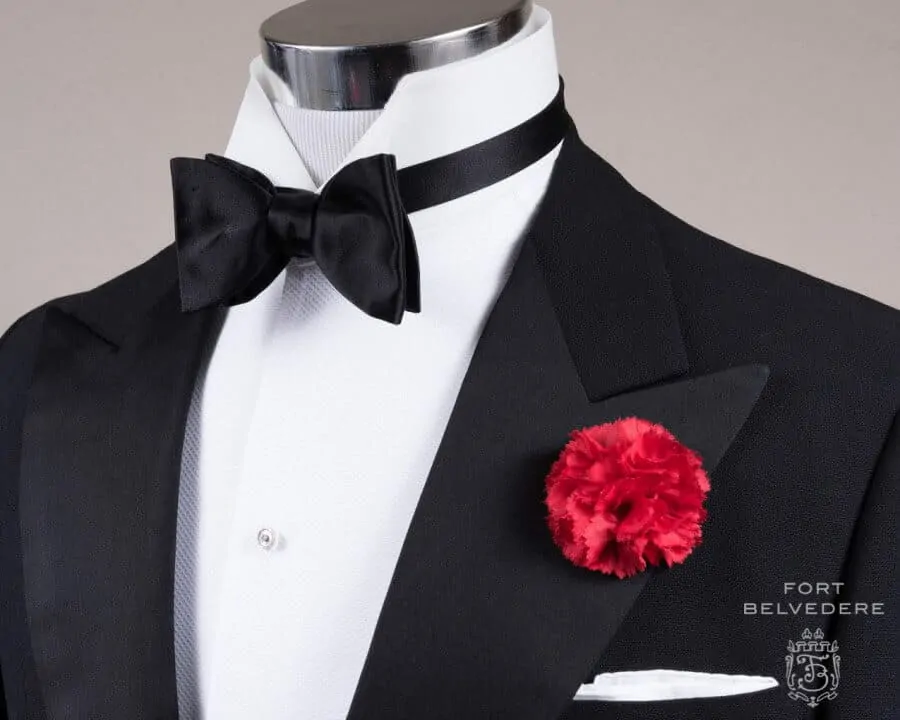
Buttonhole Boutonniere: Optional Botanical Brilliance
A boutonniere (buttonhole in the UK) can be correctly worn in the buttonhole on the left lapel of the dinner jacket. The Encyclopedia of Men’s Clothes advises that men seeking to add this classic flair to their black-tie outfit will require a flower that is small yet sturdy: “You don’t want it “clown” size, nor do you want it to disintegrate while wearing”. A white or deep red carnation is the most classic choice. For wedding boutonniere options see the Formal Evening Weddings page.
Note that flowers such as standard carnations cannot be simply purchased from a shop and inserted into a lapel because the bud is usually too thick to fit through the buttonhole. To ensure that such flowers fit properly The Boutonniere: Style in One’s Lapel suggests that they be adapted into true boutonnieres. A florist will remove the bud, wrap the stem and even level the base of the flower all so that the bloom sits flat against the lapel. The problem is, most florists these days do not know how to do that. On top of that, natural flowers wilt and when you are in a remote location or on a cruise ship the only option are artificial bouttonieres.
Even in the 1930s men would wear silk boutonnieres that looked like a real carnation, yet they would never wilt and always look fresh. For a selection of handcrafted silk boutonnieres, take a look here.
Remembering that boutonniere is French for “button hole” will help you remember that these flowers are inserted through the lapel, not pinned on top of it. Also, keep in mind that a boutonniere is not a miniature bouquet; the stereotypical accouterments of baby’s breath, leafy stems and colored berries belong at a wedding, not at a black-tie gala.
Boutonnieres are not worn with decorations. And to avoid gilding the lily (so to speak), it is also best not to combine them with pocket squares unless one or both are white.
A Note About Remembrance Poppies
Since World War I, wearing an artificial poppy to commemorate the sacrifice of veterans and civilians in past wars has been a popular tradition in many Commonwealth countries prior to Remembrance Day or Armistice Day on November 11. To a much lesser extent, the practice also exists in the United States in the weeks preceding Memorial Day on the last Monday in May. It is every bit as appropriate on a tuxedo as it is on any other type of jacket.
General etiquette for the wearing of lapel poppies varies by country. In Britain, it is governed by the Royal British Legion (although tradition varies in the UK), in Canada by the Royal Canadian Legion, in Australia by the RSL (Returned and Services League) and in America by the Veterans of Foreign Wars.
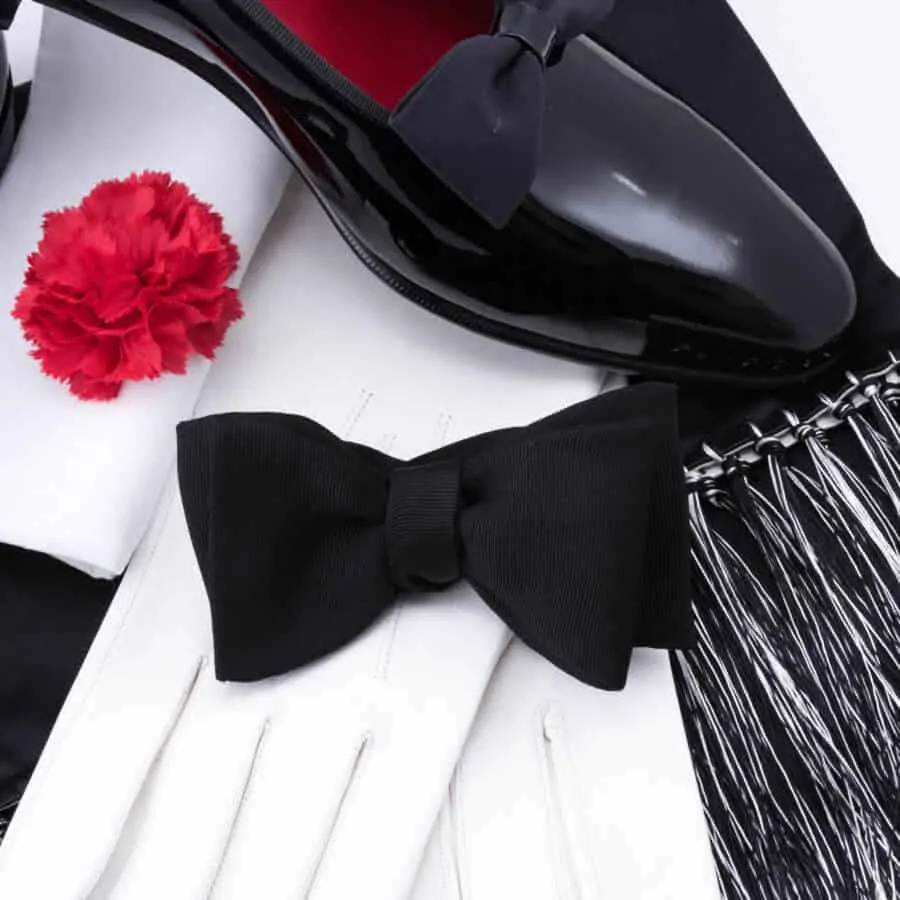
Evening Scarf: Optional Outerwear
The evening scarf worn with overcoats can be worn indoors as an accessory on, particularly formal evenings. Sometimes known as an opera scarf, it is more commonly seen in Britain than in North America. Classic colors are all white or double-sided in black and white silk.
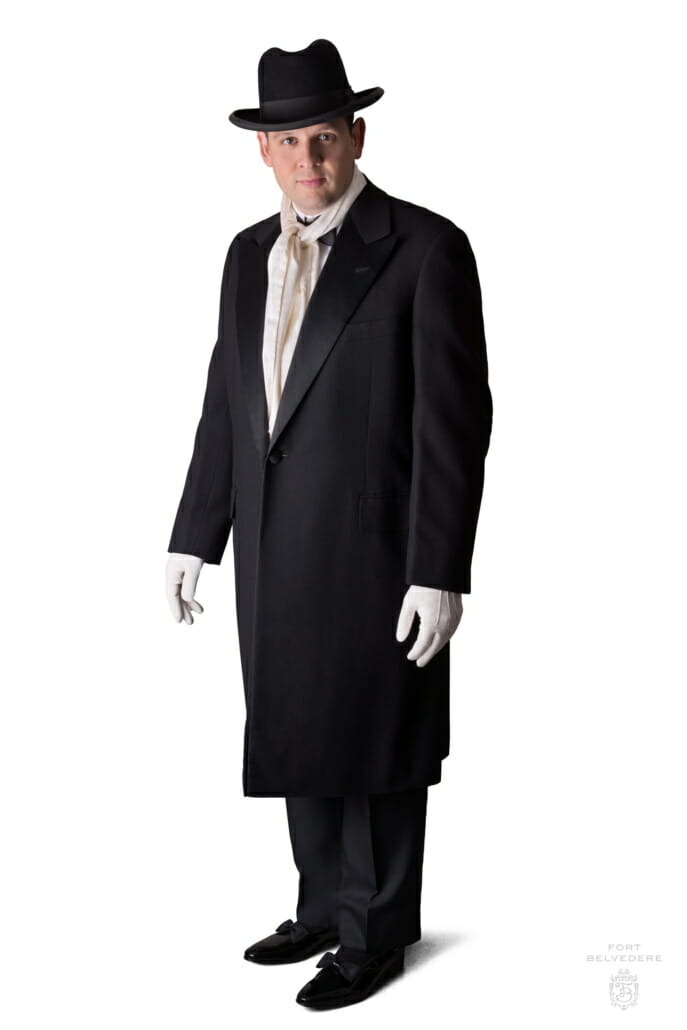
Evening Dress Gloves: Handy Option
Outside of a few rare white-tie balls, and military dress uniforms indoor white glove are hardly ever worn anymore and usually only something for vintage enthusiasts. For more about outdoor white gloves, check the Classic Black Tie Outerwear section.
Jewelry: Rings
Traditionally, gentlemen would wear rings with black tie ensembles. It could be the pinky Ring or a pinky ring or signet ring. The choice is your’s of course but one ring per hand is the most you should wear, unless of course, you stack rings on the same finger, like Prince Charles does.
Explore this chapter: 4 Classic Black Tie – The Gold Standard
- 4.1 Classic Tuxedo – Dinner Suits
- 4.2 Classic Evening Waistcoats, Vests, & Cummerbunds
- 4.3 Classic Tuxedo Shirts
- 4.4 Classic Neckwear – The Black Bow Tie
- 4.5 How To Find The Right Black Bow Tie For Your Tux and Face
- 4.6 Classic Tuxedo Shoes – Patent Leather Oxfords & Pumps
- 4.7 Classic Accessories – Cufflinks, Studs & Co
- 4.8 Classic Black Tie Outerwear
- 4.9 Warm-Weather Black Tie – The (Off) White Dinner Jacket
- 4.10 Classic Tuxedo Alternatives – How To Stand Out in Black Tie
- 4.11 Non-Traditional Dinner Jacket Guide
